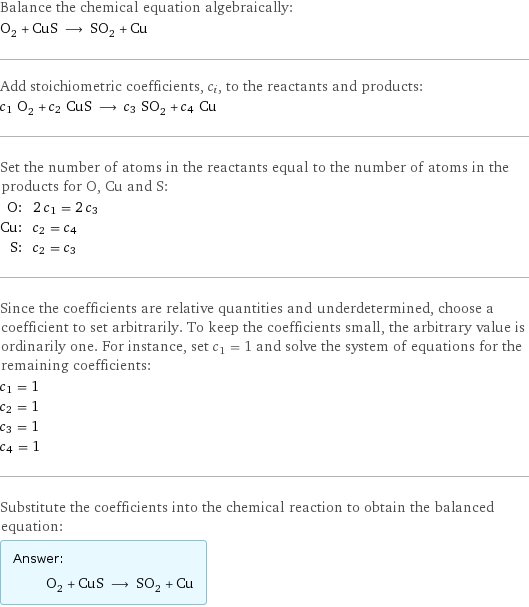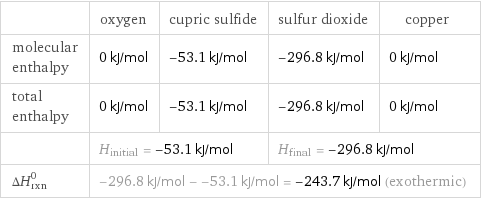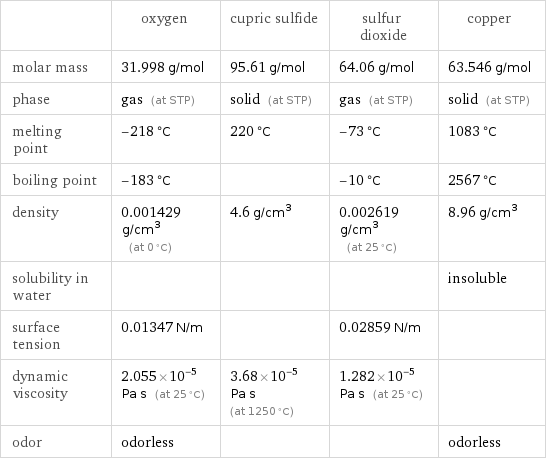Input interpretation

O_2 oxygen + CuS cupric sulfide ⟶ SO_2 sulfur dioxide + Cu copper
Balanced equation

Balance the chemical equation algebraically: O_2 + CuS ⟶ SO_2 + Cu Add stoichiometric coefficients, c_i, to the reactants and products: c_1 O_2 + c_2 CuS ⟶ c_3 SO_2 + c_4 Cu Set the number of atoms in the reactants equal to the number of atoms in the products for O, Cu and S: O: | 2 c_1 = 2 c_3 Cu: | c_2 = c_4 S: | c_2 = c_3 Since the coefficients are relative quantities and underdetermined, choose a coefficient to set arbitrarily. To keep the coefficients small, the arbitrary value is ordinarily one. For instance, set c_1 = 1 and solve the system of equations for the remaining coefficients: c_1 = 1 c_2 = 1 c_3 = 1 c_4 = 1 Substitute the coefficients into the chemical reaction to obtain the balanced equation: Answer: | | O_2 + CuS ⟶ SO_2 + Cu
Structures

+ ⟶ +
Names

oxygen + cupric sulfide ⟶ sulfur dioxide + copper
Reaction thermodynamics
Enthalpy

| oxygen | cupric sulfide | sulfur dioxide | copper molecular enthalpy | 0 kJ/mol | -53.1 kJ/mol | -296.8 kJ/mol | 0 kJ/mol total enthalpy | 0 kJ/mol | -53.1 kJ/mol | -296.8 kJ/mol | 0 kJ/mol | H_initial = -53.1 kJ/mol | | H_final = -296.8 kJ/mol | ΔH_rxn^0 | -296.8 kJ/mol - -53.1 kJ/mol = -243.7 kJ/mol (exothermic) | | |
Entropy

| oxygen | cupric sulfide | sulfur dioxide | copper molecular entropy | 205 J/(mol K) | 67 J/(mol K) | 248 J/(mol K) | 33 J/(mol K) total entropy | 205 J/(mol K) | 67 J/(mol K) | 248 J/(mol K) | 33 J/(mol K) | S_initial = 272 J/(mol K) | | S_final = 281 J/(mol K) | ΔS_rxn^0 | 281 J/(mol K) - 272 J/(mol K) = 9 J/(mol K) (endoentropic) | | |
Equilibrium constant
![Construct the equilibrium constant, K, expression for: O_2 + CuS ⟶ SO_2 + Cu Plan: • Balance the chemical equation. • Determine the stoichiometric numbers. • Assemble the activity expression for each chemical species. • Use the activity expressions to build the equilibrium constant expression. Write the balanced chemical equation: O_2 + CuS ⟶ SO_2 + Cu Assign stoichiometric numbers, ν_i, using the stoichiometric coefficients, c_i, from the balanced chemical equation in the following manner: ν_i = -c_i for reactants and ν_i = c_i for products: chemical species | c_i | ν_i O_2 | 1 | -1 CuS | 1 | -1 SO_2 | 1 | 1 Cu | 1 | 1 Assemble the activity expressions accounting for the state of matter and ν_i: chemical species | c_i | ν_i | activity expression O_2 | 1 | -1 | ([O2])^(-1) CuS | 1 | -1 | ([CuS])^(-1) SO_2 | 1 | 1 | [SO2] Cu | 1 | 1 | [Cu] The equilibrium constant symbol in the concentration basis is: K_c Mulitply the activity expressions to arrive at the K_c expression: Answer: | | K_c = ([O2])^(-1) ([CuS])^(-1) [SO2] [Cu] = ([SO2] [Cu])/([O2] [CuS])](../image_source/c20eaec5f6d2a8bab9f1ec02757ea781.png)
Construct the equilibrium constant, K, expression for: O_2 + CuS ⟶ SO_2 + Cu Plan: • Balance the chemical equation. • Determine the stoichiometric numbers. • Assemble the activity expression for each chemical species. • Use the activity expressions to build the equilibrium constant expression. Write the balanced chemical equation: O_2 + CuS ⟶ SO_2 + Cu Assign stoichiometric numbers, ν_i, using the stoichiometric coefficients, c_i, from the balanced chemical equation in the following manner: ν_i = -c_i for reactants and ν_i = c_i for products: chemical species | c_i | ν_i O_2 | 1 | -1 CuS | 1 | -1 SO_2 | 1 | 1 Cu | 1 | 1 Assemble the activity expressions accounting for the state of matter and ν_i: chemical species | c_i | ν_i | activity expression O_2 | 1 | -1 | ([O2])^(-1) CuS | 1 | -1 | ([CuS])^(-1) SO_2 | 1 | 1 | [SO2] Cu | 1 | 1 | [Cu] The equilibrium constant symbol in the concentration basis is: K_c Mulitply the activity expressions to arrive at the K_c expression: Answer: | | K_c = ([O2])^(-1) ([CuS])^(-1) [SO2] [Cu] = ([SO2] [Cu])/([O2] [CuS])
Rate of reaction
![Construct the rate of reaction expression for: O_2 + CuS ⟶ SO_2 + Cu Plan: • Balance the chemical equation. • Determine the stoichiometric numbers. • Assemble the rate term for each chemical species. • Write the rate of reaction expression. Write the balanced chemical equation: O_2 + CuS ⟶ SO_2 + Cu Assign stoichiometric numbers, ν_i, using the stoichiometric coefficients, c_i, from the balanced chemical equation in the following manner: ν_i = -c_i for reactants and ν_i = c_i for products: chemical species | c_i | ν_i O_2 | 1 | -1 CuS | 1 | -1 SO_2 | 1 | 1 Cu | 1 | 1 The rate term for each chemical species, B_i, is 1/ν_i(Δ[B_i])/(Δt) where [B_i] is the amount concentration and t is time: chemical species | c_i | ν_i | rate term O_2 | 1 | -1 | -(Δ[O2])/(Δt) CuS | 1 | -1 | -(Δ[CuS])/(Δt) SO_2 | 1 | 1 | (Δ[SO2])/(Δt) Cu | 1 | 1 | (Δ[Cu])/(Δt) (for infinitesimal rate of change, replace Δ with d) Set the rate terms equal to each other to arrive at the rate expression: Answer: | | rate = -(Δ[O2])/(Δt) = -(Δ[CuS])/(Δt) = (Δ[SO2])/(Δt) = (Δ[Cu])/(Δt) (assuming constant volume and no accumulation of intermediates or side products)](../image_source/2af53afcb2f3068f9ec8e929afdd82d6.png)
Construct the rate of reaction expression for: O_2 + CuS ⟶ SO_2 + Cu Plan: • Balance the chemical equation. • Determine the stoichiometric numbers. • Assemble the rate term for each chemical species. • Write the rate of reaction expression. Write the balanced chemical equation: O_2 + CuS ⟶ SO_2 + Cu Assign stoichiometric numbers, ν_i, using the stoichiometric coefficients, c_i, from the balanced chemical equation in the following manner: ν_i = -c_i for reactants and ν_i = c_i for products: chemical species | c_i | ν_i O_2 | 1 | -1 CuS | 1 | -1 SO_2 | 1 | 1 Cu | 1 | 1 The rate term for each chemical species, B_i, is 1/ν_i(Δ[B_i])/(Δt) where [B_i] is the amount concentration and t is time: chemical species | c_i | ν_i | rate term O_2 | 1 | -1 | -(Δ[O2])/(Δt) CuS | 1 | -1 | -(Δ[CuS])/(Δt) SO_2 | 1 | 1 | (Δ[SO2])/(Δt) Cu | 1 | 1 | (Δ[Cu])/(Δt) (for infinitesimal rate of change, replace Δ with d) Set the rate terms equal to each other to arrive at the rate expression: Answer: | | rate = -(Δ[O2])/(Δt) = -(Δ[CuS])/(Δt) = (Δ[SO2])/(Δt) = (Δ[Cu])/(Δt) (assuming constant volume and no accumulation of intermediates or side products)
Chemical names and formulas

| oxygen | cupric sulfide | sulfur dioxide | copper formula | O_2 | CuS | SO_2 | Cu Hill formula | O_2 | CuS | O_2S | Cu name | oxygen | cupric sulfide | sulfur dioxide | copper IUPAC name | molecular oxygen | | sulfur dioxide | copper
Substance properties

| oxygen | cupric sulfide | sulfur dioxide | copper molar mass | 31.998 g/mol | 95.61 g/mol | 64.06 g/mol | 63.546 g/mol phase | gas (at STP) | solid (at STP) | gas (at STP) | solid (at STP) melting point | -218 °C | 220 °C | -73 °C | 1083 °C boiling point | -183 °C | | -10 °C | 2567 °C density | 0.001429 g/cm^3 (at 0 °C) | 4.6 g/cm^3 | 0.002619 g/cm^3 (at 25 °C) | 8.96 g/cm^3 solubility in water | | | | insoluble surface tension | 0.01347 N/m | | 0.02859 N/m | dynamic viscosity | 2.055×10^-5 Pa s (at 25 °C) | 3.68×10^-5 Pa s (at 1250 °C) | 1.282×10^-5 Pa s (at 25 °C) | odor | odorless | | | odorless
Units
